

Matt Campbell
2026 MG U9 review
4 Hours Ago
The new Isuzu D-Max X-Terrain is a massive step up on its predecessor, and should convert some Ranger and HiLux buyers to the cause. But in a straight line, it can't match the Amarok V6. So is this old warhorse still worth a look?

Senior Contributor
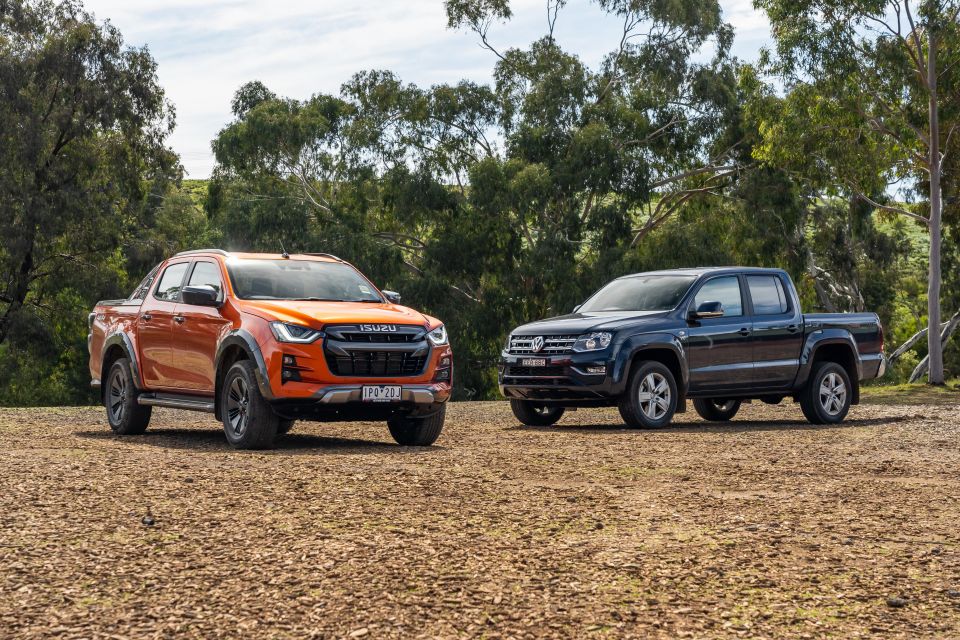

Senior Contributor
The new Isuzu D-Max has been receiving a heap of plaudits since its recent launch. It’s clearly a huge step up over its predecessor model in terms of cabin presentation, technology, and safety.
Next to its main competitors – the Ford Ranger and Toyota HiLux being the top-two by sales – it stacks up very well indeed. But there’s another rival, the Volkswagen Amarok, that’s worth looking into.
The Amarok is as old as the hills now, having been around for a decade with only a few updates. But when it comes to delivering the most diesel grunt for the money, it’s still the class leader.
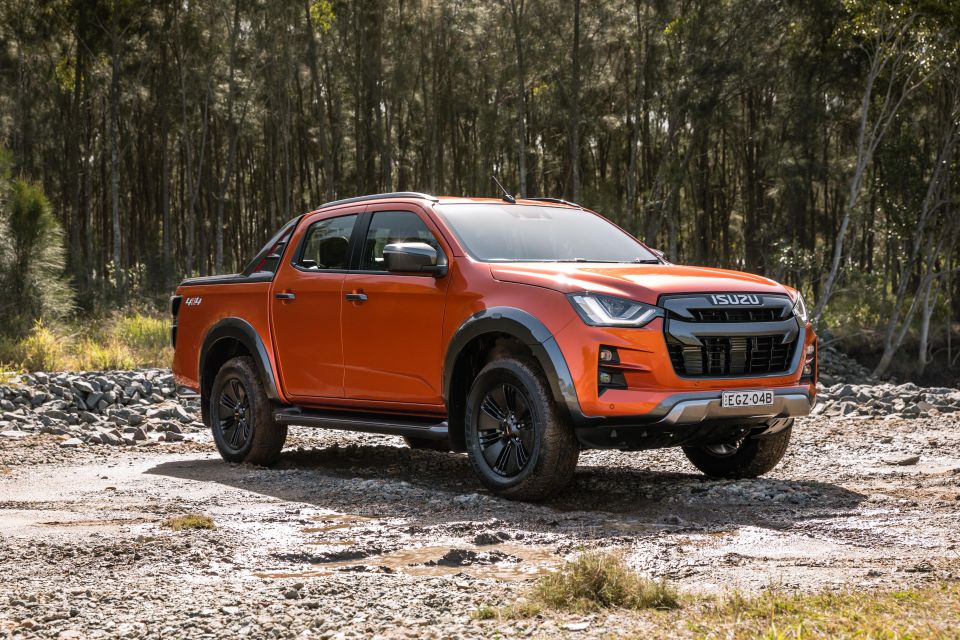
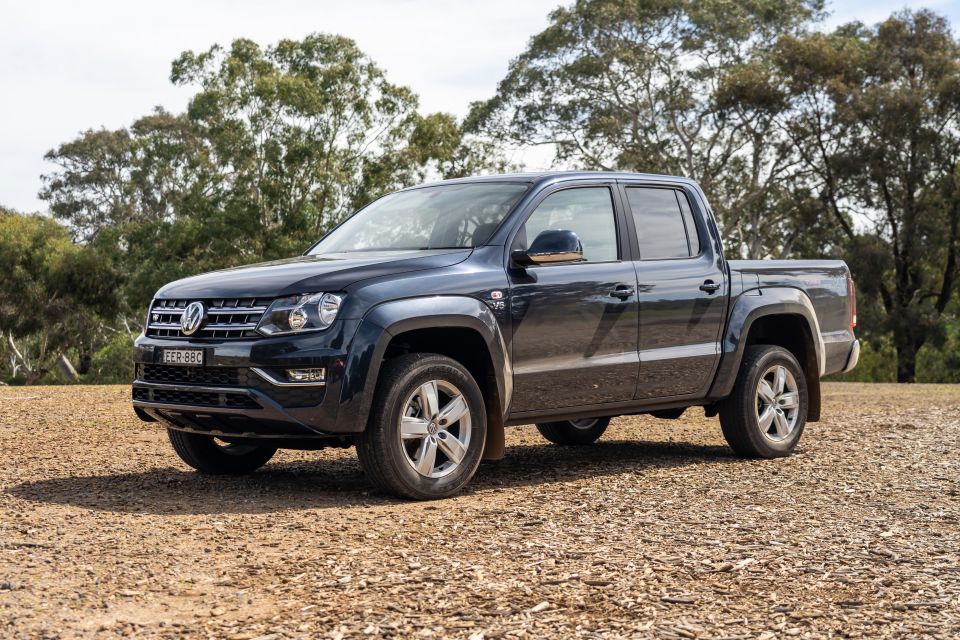
On a side note, we know what you’re thinking: why have we published a test between the D-Max and Amarok, before the D-Max and HiLux/Ranger?
The short answer is, COVID-19. The bulk of our road testing team is Melbourne-based, and we’ve had multiple plans to conduct that very test rescheduled by Stage 4 restrictions and subsequent press-car postponements. Bear with us, we’re working hard to get that done as well.
On a side note, check out our detailed video reviews of both vehicles: the D-Max video review is immediately below, and the Amarok video review is situated further down this story.
So there are list prices, and then there are real prices.
The D-Max in flagship X-Terrain form as tested here wears a retail price of $62,900 before on-road costs. The best Amarok competitor grade is the Highline ($61,090 before on-roads), but for matters of press-fleet availability we have the Sportline here ($56,590 before on-roads).
You’re never paying those figures though. The D-Max X-Terrain is already retailing for $58,990 drive-away, while the Amarok Sportline was retailing for $54,990 drive-away at the time of writing, and the Highline on runout was listed at $59,990 drive-away. The latter is soon to receive an engine update I’ll detail shortly.
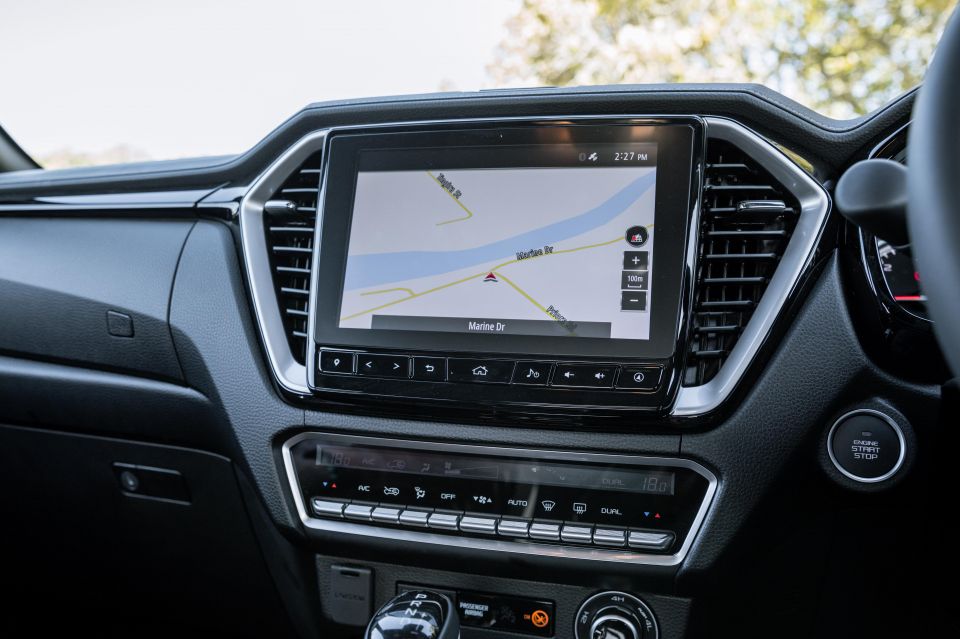
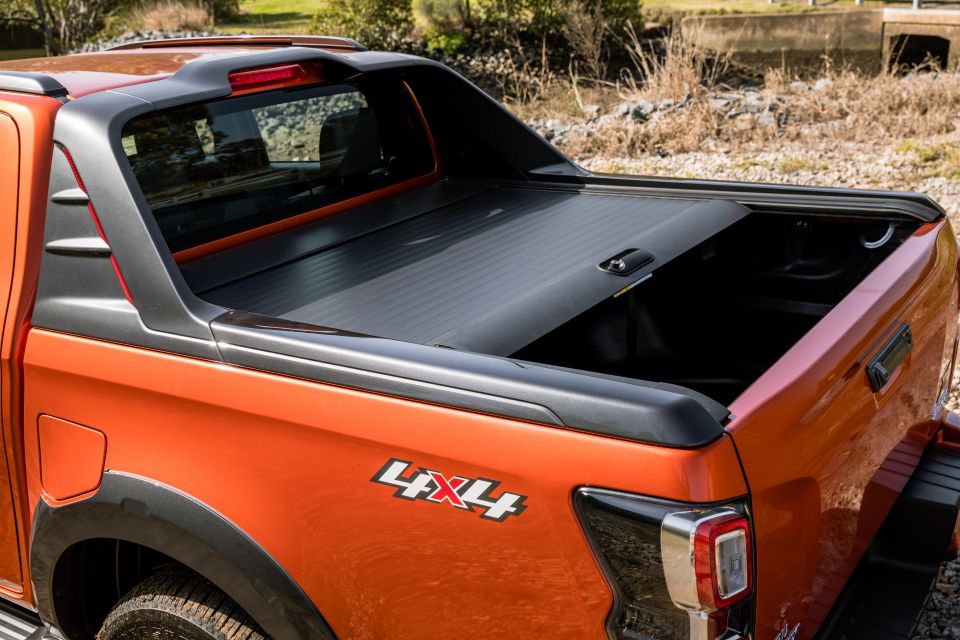
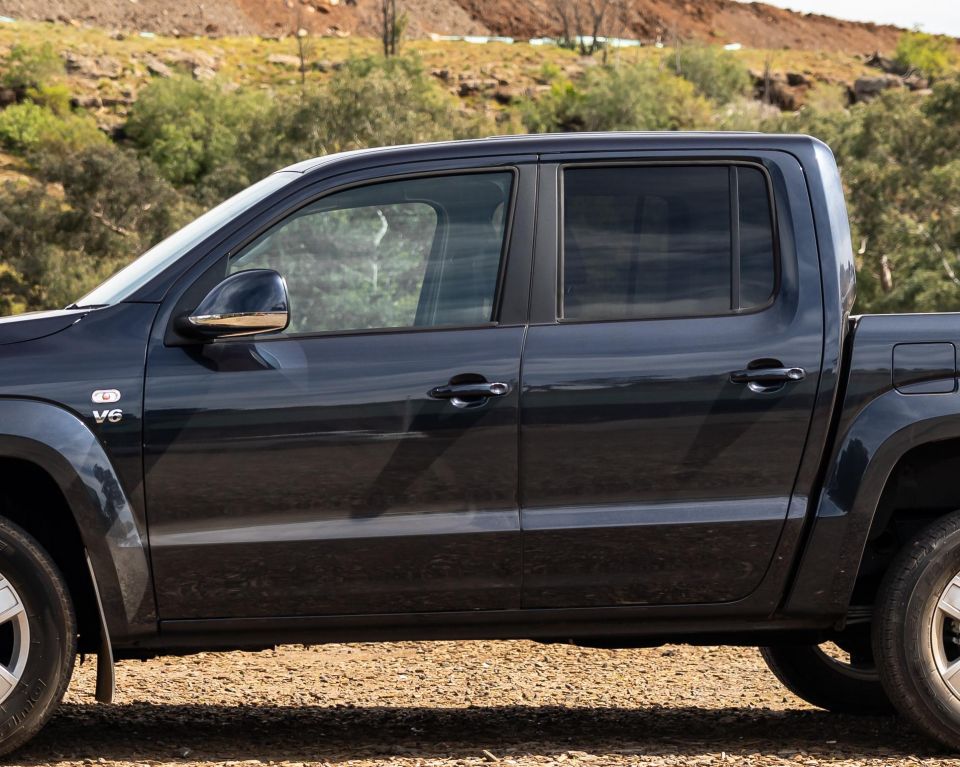
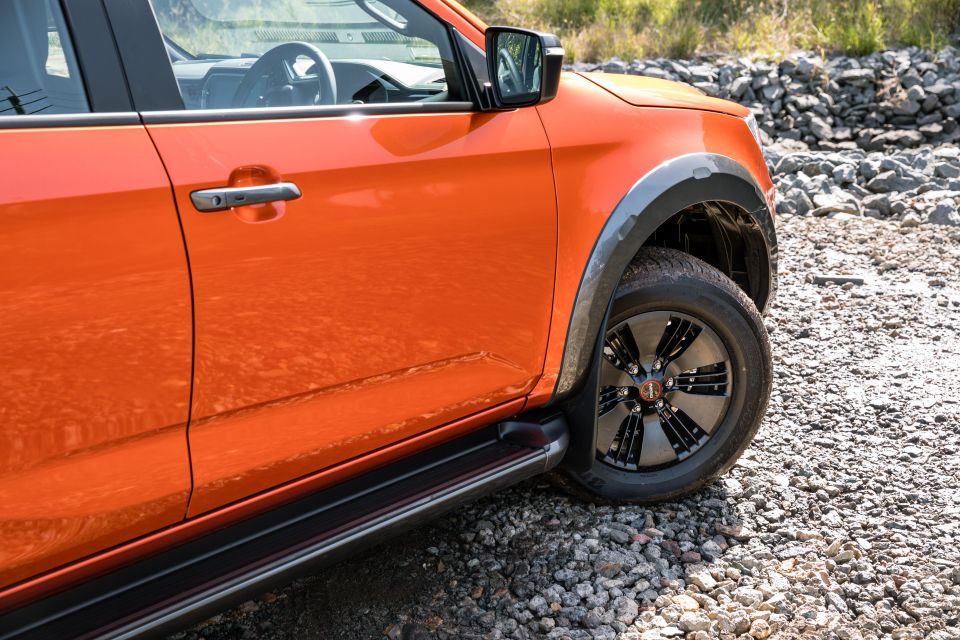
Both tested cars are fitted with 18-inch wheels and Bridgestone Dueler HT tyres, and have auto-on/off wipers, dual-zone climate control, touchscreens, Apple CarPlay and Android Auto, Bluetooth/USB inputs, parking sensors at both ends, and rear cameras.
The Amarok has darker rear privacy glass, but the D-Max alone adds extras such as sat-nav, wireless Apple CarPlay rather than wired, leather seats with electric adjustment for the driver, Bi-LED headlights instead of halogens, remote engine start, a proximity key fob and button start, and two more speakers (8 versus 6).
The Isuzu also gets a protective tub liner, a matte black roller hard-tonneau cover, a body kit including that colour-matched sports ‘bar’, and side steps.
If you step up into the aforementioned Amarok Highline you’ll get extras over the Sportline such as satellite navigation, a tyre-pressure monitor, steel sports bar in the tub, bi-xenon headlights with LED daytime running lights, and side steps.
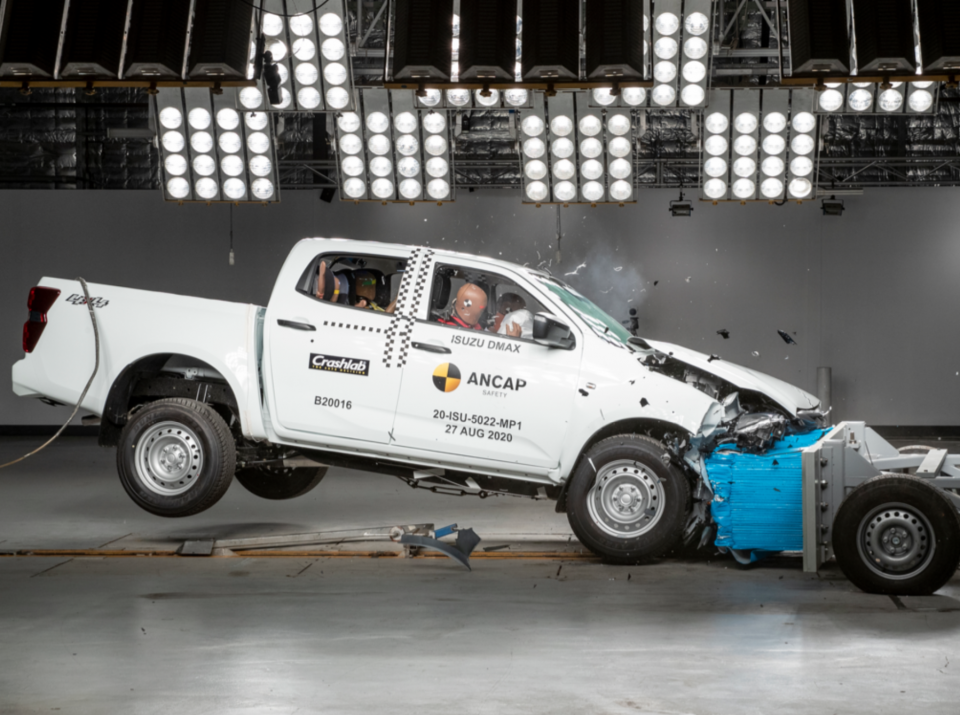
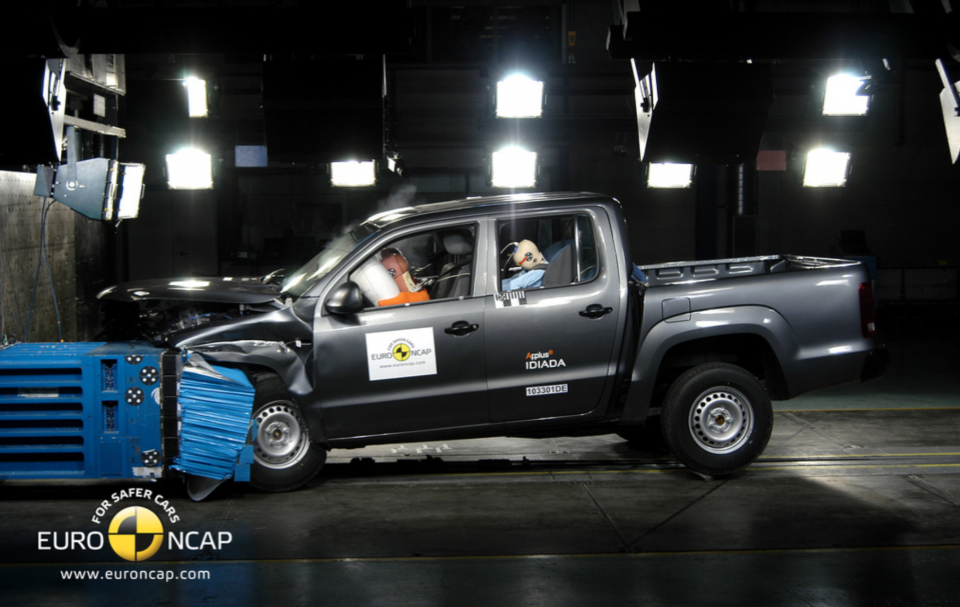
There’s a significant gulf here between the brand new Isuzu and its much older Volkswagen competitor. It shows how far expectations around the safety features in commercial vehicles have come over the last decade.
The Isuzu is arguably the safest dual-cab ute going at the moment, since it’s the first to achieve five stars from crash-tester ANCAP’s latest 2020 criteria: 83 per cent for adult safety, 89 per cent for child safety, 69 per cent for vulnerable road-user safety, and 81 per cent for safety assist features.
Safety features include eight airbags (dual front, dual front-seat-side, both-row-curtains, driver’s knee, and even one that deploys between the front occupants).
Other standard features include stereo-camera-driven autonomous emergency braking, post-collision braking, forward collision alert, active cruise control, misacceleration mitigation, lane-departure warning, lane-keeping aid, traffic-sign recognition, blind-spot monitoring, rear cross-traffic alert, a driver-attention monitor, and automatic high-beam.
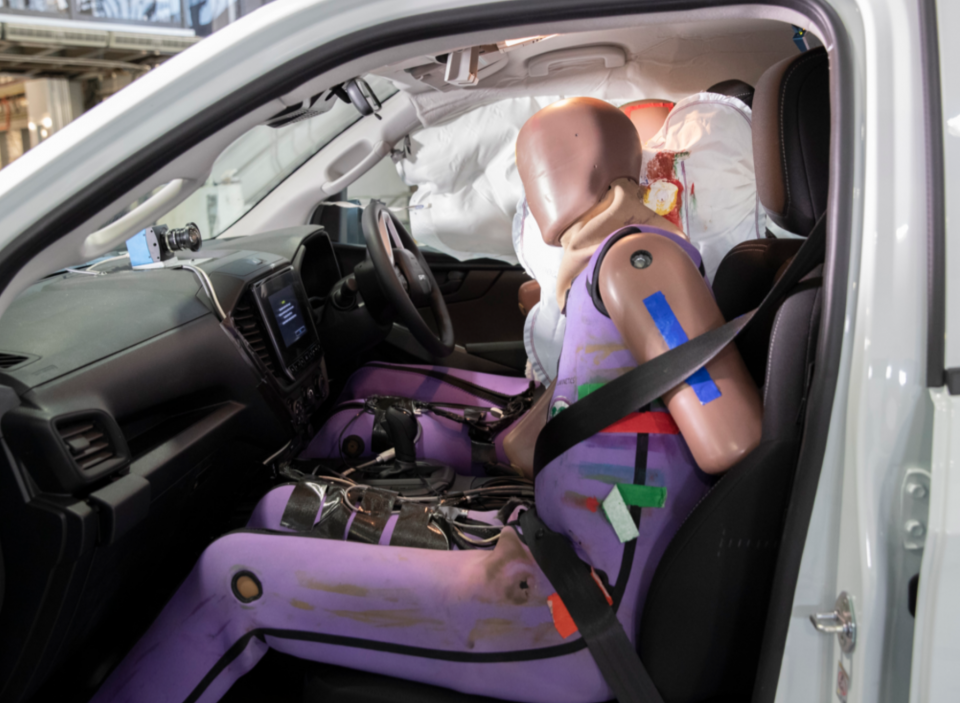
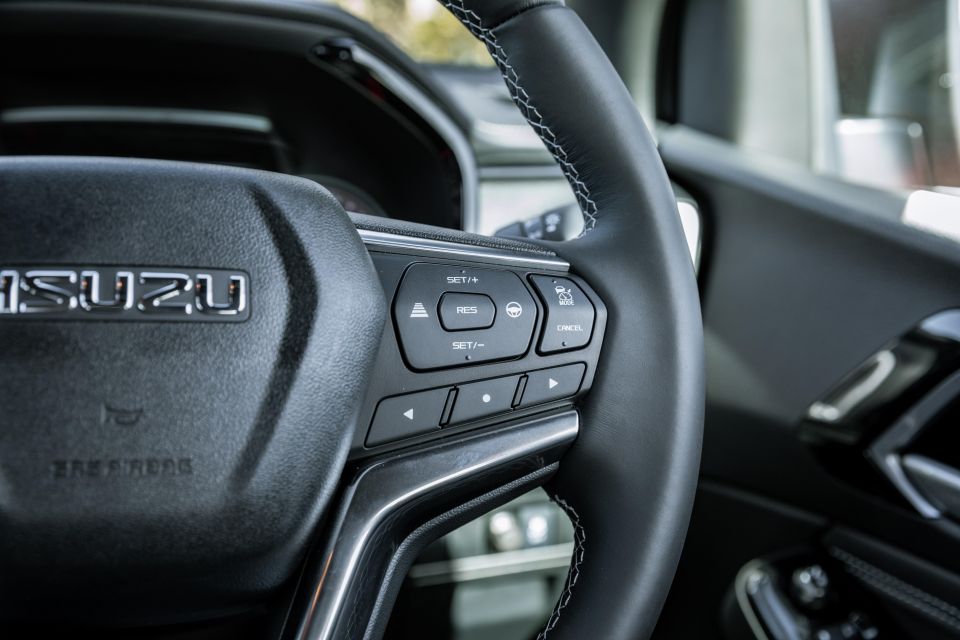
The linked report above breaks down how well these systems worked under controlled emergency testing procedures.
ANCAP also gave the Amarok five stars, but that was way back in 2011 when the testing criteria were quite a bit different. In testing it handled a frontal offset impact test quite well, scoring 13.99 out of 16.
But the list of safety features is sparse next to most of its competitors these days. You get dual-front airbags and dual-front head and thorax side ‘bags, but there are no curtains protecting rear occupants from side impacts at all. It’s the only ute in its class that lacks rear airbags nowadays.
Safety systems include a trailer-sway control system programmed into the stability control, and a multi-collision braking system. There are also rear ISOFIX and top-tether anchor points (steel rings behind the seatback) for child seats, though if you’re using your dual-cab to cart back-seat passengers, we’d suggest you strike the Amarok from your list.
None of the D-Max’s listed active safety systems are available in the Volkswagen. If tested today, it simply could not achieve five stars.
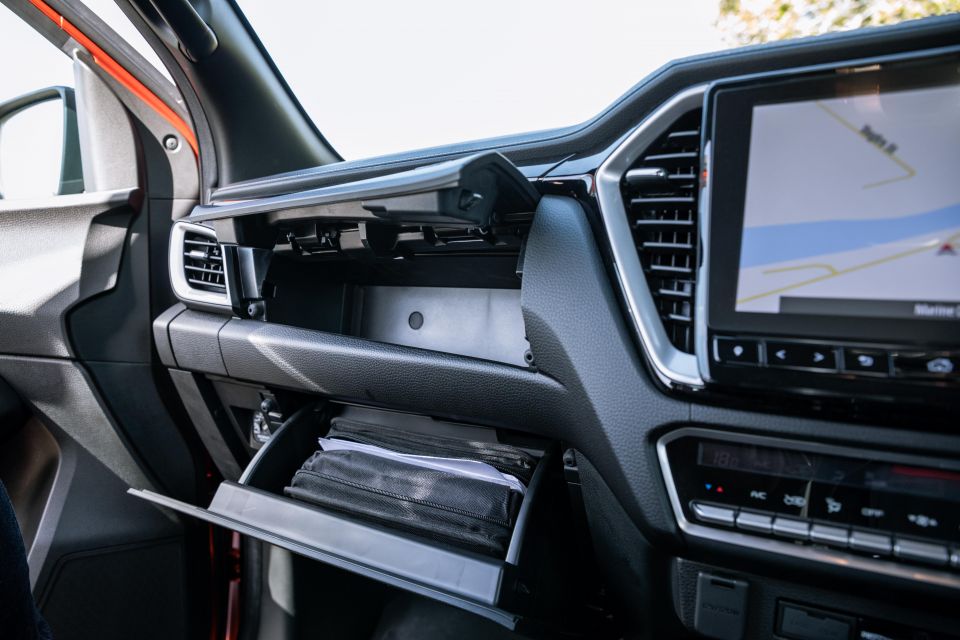
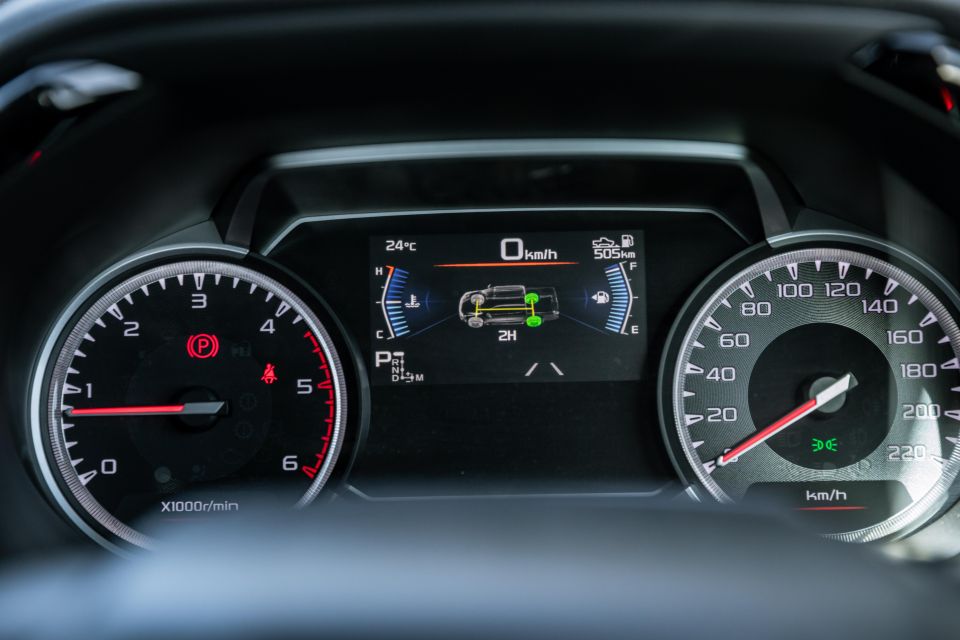
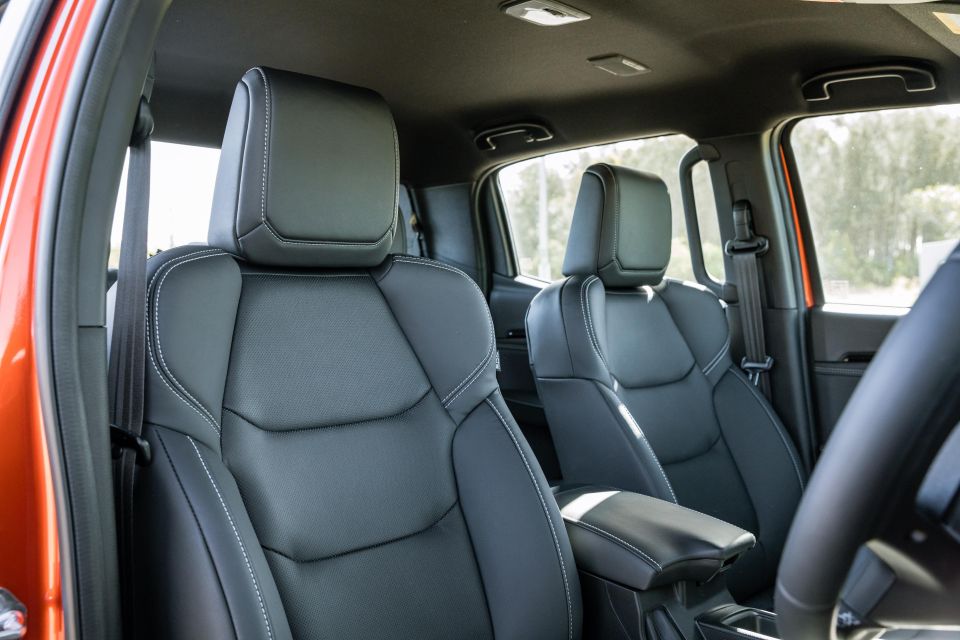

Isuzu
The Isuzu’s cabin is chalk and cheese against the old one. The materials are hard-wearing but the padded bits on key touchpoints like the wheel and armrests are tactile and ‘premium’.
The seats are really well-bolstered (they remind me of a VF Commodore’s), and there’s finally telescopic steering column adjustment. Ahead of the driver is a colour TFT display offering trip computer information, safety system status, a traffic sign recognition system, and a number of vehicle settings.
The centre screen is large, and while its user interface isn’t instantly intuitive, you adjust quickly. Its response times are sufficiently quick, and there are handy shortcut buttons below. You get sat-nav, DAB+ and conventional wired Android Auto, but also nifty wireless Apple CarPlay that auto-loads once you’re paired up.
For the most part it works, and allows voice commands to be forwarded to your phone’s cloud-based voice recognition system as an alternative to the inbuilt unit.
Below the screen is a simple climate control system controlled by rocker switches, and below this lie the USB and 12V plugs, plus the electro-mechanical 4×4 switch.
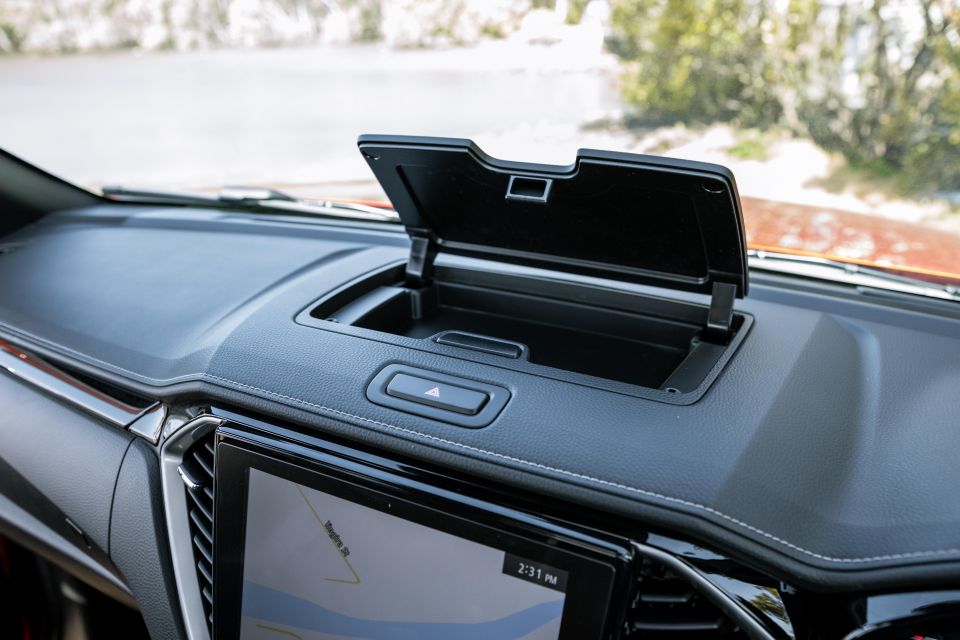
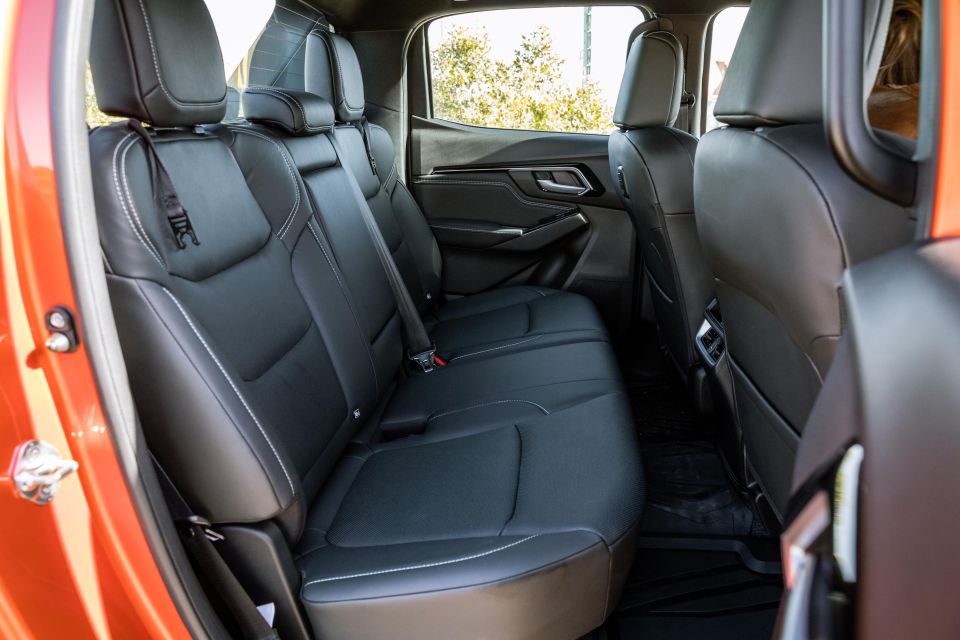
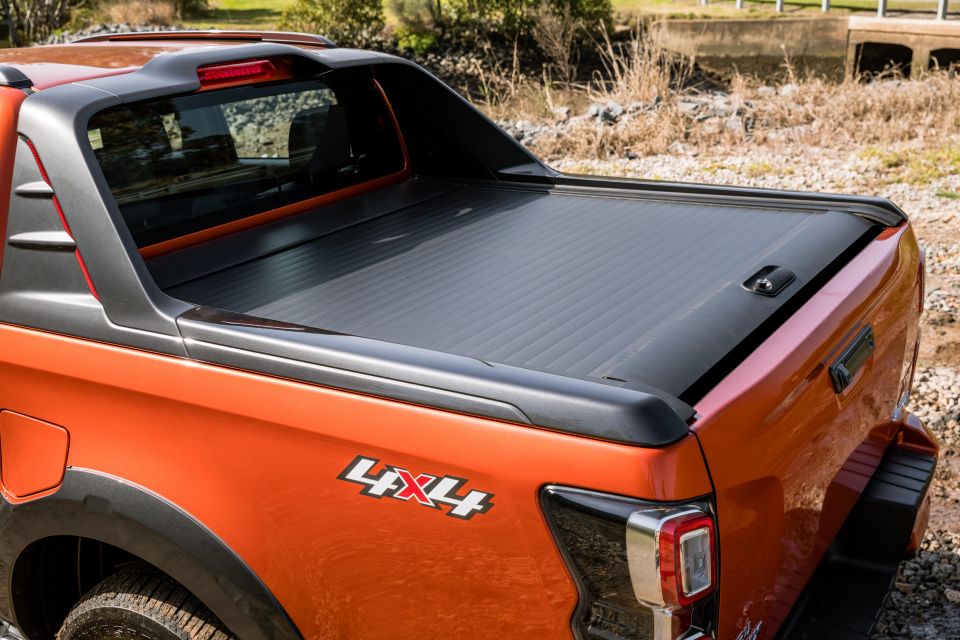
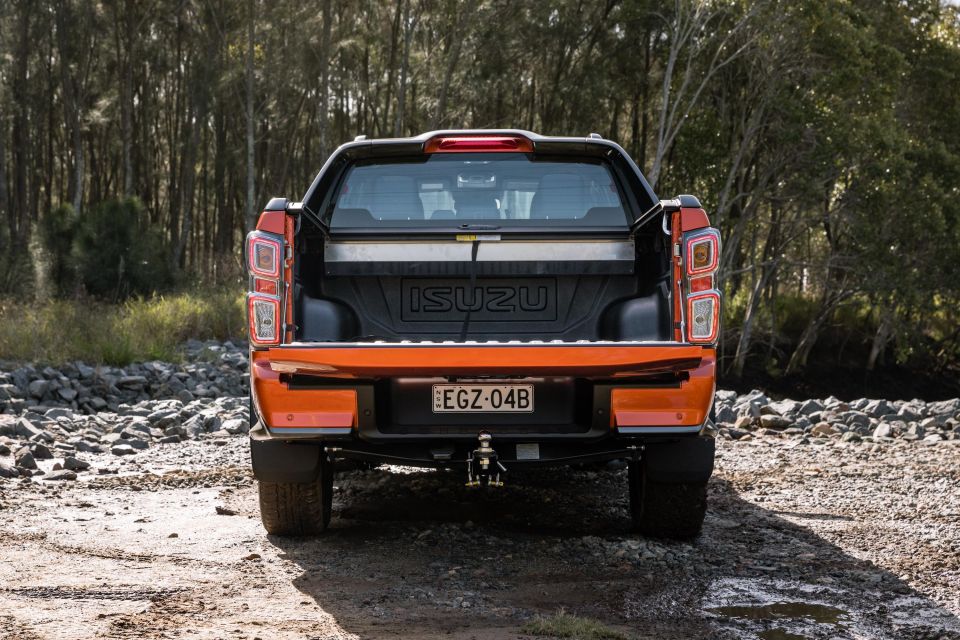
Storage options include HiLux-style twin gloveboxes, a decent-size centre console, a closing dashtop cubby (which, unlike the old D-Max’s, opens and shuts seamlessly), big door bins, and slide-out cupholders mounted up high near the outboard dash vents.
Second row legroom is good but not amazing. Likewise toe room, but there was adequate headroom and the second row feels spacious for an adult. You’ll find rear air vents, USB power, and a centre arm rest.
The second row folds upwards at its base to reveal storage beneath the seat, and the seat back folds to access a shared top tether point. ISOFIX points are also available on the two outboard seats. We liked the inclusion of a hook behind the passenger seat for shopping bags and other bits and pieces that have a habit of flying around the cabin.
When it comes to the tray, the X-Terrain comes fitted with a lockable roller blind cover. It works pretty well and is easy to use – it just requires a bit of manhandling to close. It’d be nice to see a motorised version available as an option to make this task easier, but we’re getting carried away…
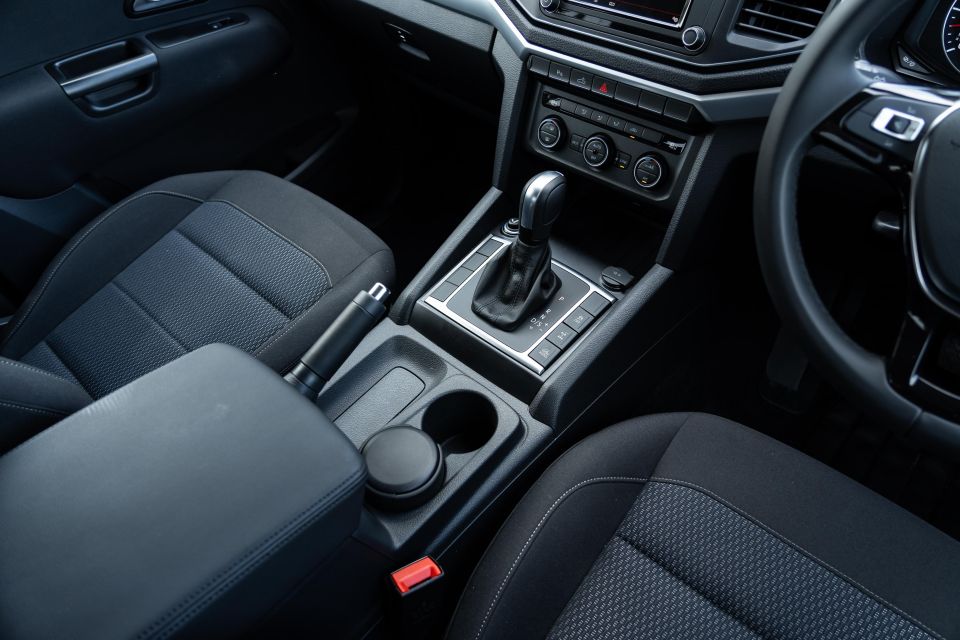


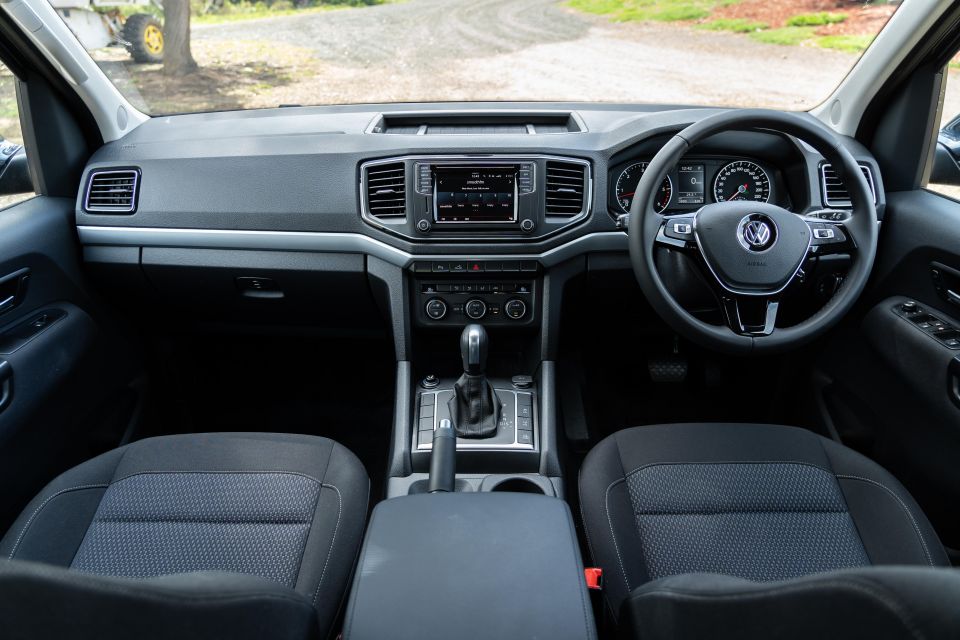
Volkswagen
The Amarok’s cabin is wide and there’s ample steering wheel and seat adjustment, plus good outboard visibility. You’re swiftly comfortable.
But it’s all pretty dated, from the presence of an ignition barrel, the cloth-trimmed manual seats, the small 6.3-inch touchscreen with wired phone mirroring only, and the dated digitised trip computer (which does have a digital speedo at least).
It’s really solidly built, with no squeaks or rattles or inconsistent shutlines, and the plastics used throughout will stand up to a beating – though in terms of trim quality and tactility it’s far more utilitarian than the comparatively sumptuous D-Max.
There are fewer lidded storage areas than the D-Max, though the classic fabric-lined door bins are a nice touch (until you spill flaky pie crust in them…).

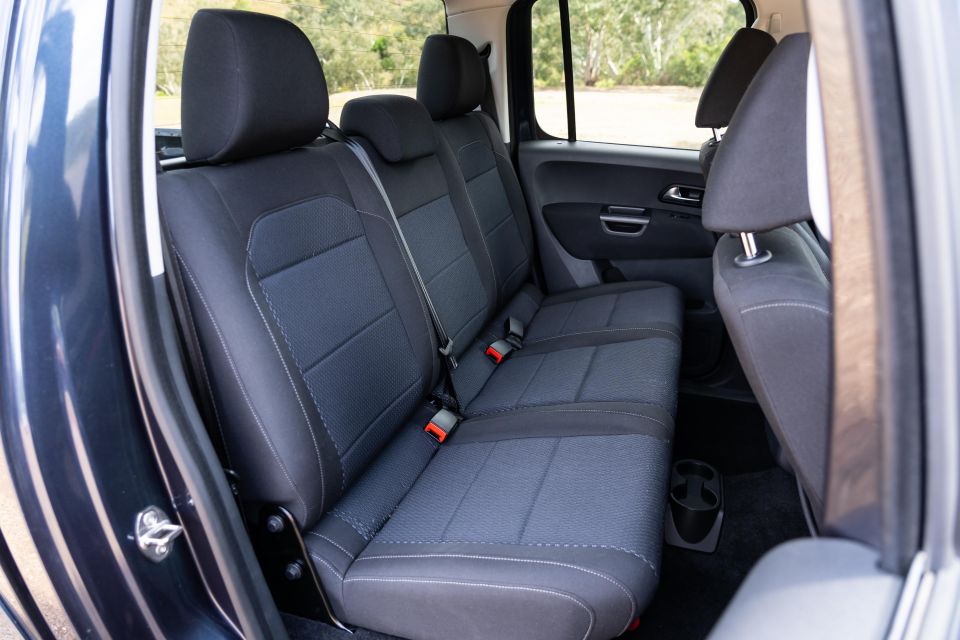
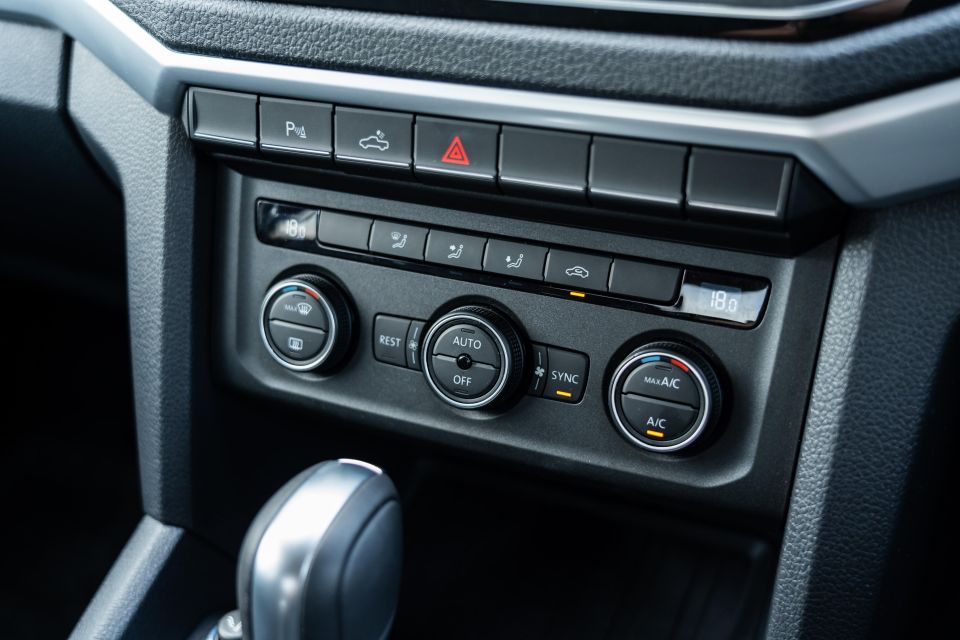

The back seats are wider and offer plentiful shoulder room, ditto toe room under the front seats. But legroom is quite limited compared to most competitors including the D-Max. At 194cm I felt quite squashed, though for shorter commutes it’s fine.
You have neither rear vents or USB, just a 12V socket. The seat base pulls up and can be attached to the headrests, and the seat-back comes down in a single piece to reveal the metal top-tether anchor points. And remember, there are no rear airbags.
Our test ute did not come with an accessory tub liner, but they’re available in the catalogue alongside a rolling tonneau and running boards, and the tailgate is not too weighty. Not only is the tub a little deeper than the D-Max’s, but it’s also far wider – including an extra 100mm between the wheel arches, sufficient to stow a typical pallet.
| Isuzu D-Max | Volkswagen Amarok | |
|---|---|---|
| Tub length | 1570mm | 1555mm |
| Tub width | 1530mm | 1620mm |
| Tub width between arches | 1122mm | 1222mm |
| Tub depth | 490mm | 508mm |
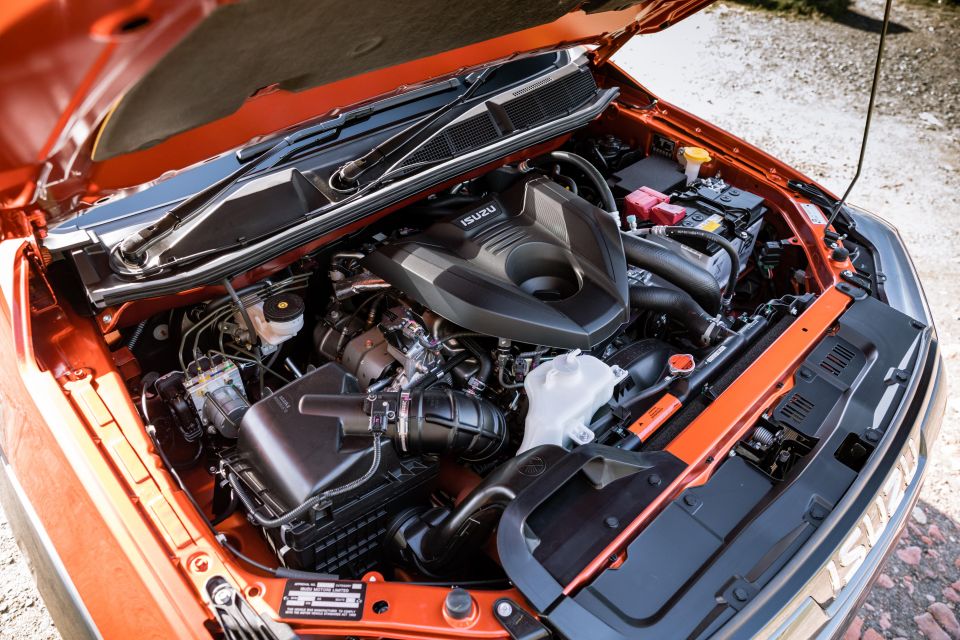
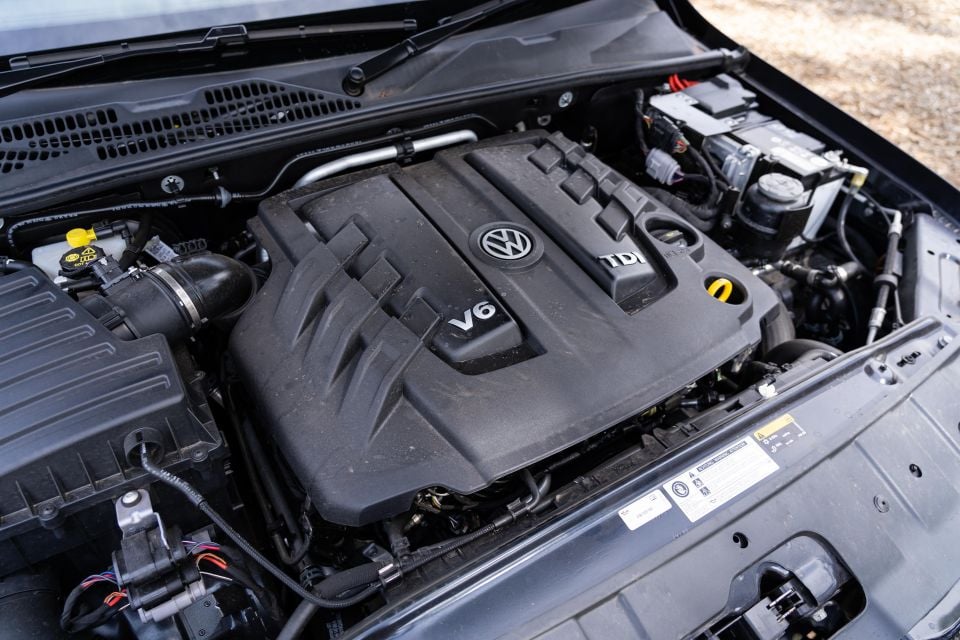
Isuzu
The Isuzu has a reworked 3.0-litre turbo-diesel donk codenamed 4JJ3-TCX. It has the same displacement as the old unit, but gets a new block, cylinder head, and crankshaft, plus lighter (aluminium) pistons, a new forward-facing intake, new variable geometry turbo, and new Denso injectors.
Outputs are up by 10kW and 20Nm, to 140kW (at 3600rpm) and 450Nm (1600 to 2600rpm). This peak torque band is five times wider than before, Isuzu claims. Yet the outputs are still 25kW/100Nm behind the Amarok, 10kW/50Nm behind a HiLux, and 17kW/50Nm behind a 2.0-litre bi-turbo Ranger.
Some key highlights worth pointing out when it comes to the engine – it uses a steel timing chain, piston crowns and pins that are coated with a diamond-like carbon, and a double scissor idler gear design.
Isuzu claims a combined-cycle fuel consumption of 8.0 litres per 100km, and my average over an unladen run was a respectable 8.8L/100km.
The engine is mated to a new six-speed automatic supplied by Aisin, and if you want a manual you need to buy the lower-grade LS-U model. Isuzu says this new ‘box shifts between ratios up to 0.2 seconds faster than before.
The D-Max has a conventional (for utes) part-time 4×4 system with default rear-wheel drive, shift-on-the-fly 4H, and proper 4L low-range.
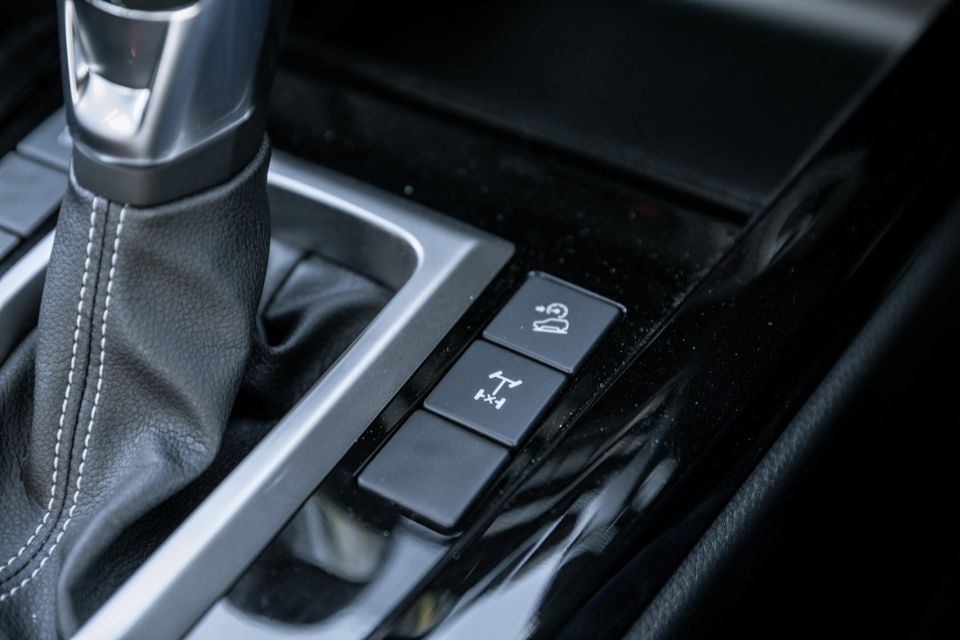

Volkswagen
If there is one area where the Volkswagen clearly leaves its far newer rival – and the entire class, for the matter – in the dust, it’s power and torque.
The 3.0-litre V6 diesel engine used in the Sportline produces 165kW, or an even better 180kW for 10 second bursts under heavy throttle, on overboost. It also makes 550Nm of torque between 1500 and 2500rpm, so just off idle.
On a side note, the Amarok V6 Highline grade mentioned earlier in the story is now (from September) available in TDI580 guise, meaning its V6 engine is uprated to 190kW (200kW on overboost) and 580Nm.
Volkswagen claims fuel consumption on the combined cycle for the Sportline of 9.1 litres per 100km, and on my mixed unladen route of urban and highway time I managed to keep the diesel consumption to a reasonable 9.4L/100km.
The engine is mated to an eight-speed automatic transmission with an aggressive Sports mode, and a unique for the class permanent 4×4 system with a Torsen mechanical differential. The default torque split front to rear is 40:60.
| Isuzu D-Max | Volkswagen Amarok | |
|---|---|---|
| Displacement | 3.0-litre | 3.0-litre |
| Cylinders | 4 | 6 |
| Max power | 140kW @ 3600rpm | 165kW @ 4500rpm |
| Max torque | 450Nm @ 1600rpm | 550Nm @ 1500rpm |
| Tow rating | 3500kg | 3500kg |
| Power to weight | 65.7kW/t | 78.4kW/t |
| Transmission | 6-speed auto | 8-speed auto |
| Fuel use | 8.0L/100km | 9.1L/100km |
| Fuel tank | 76 litres | 80 litres |
| Drive | Part-time 4×4 | Permanent 4×4 |
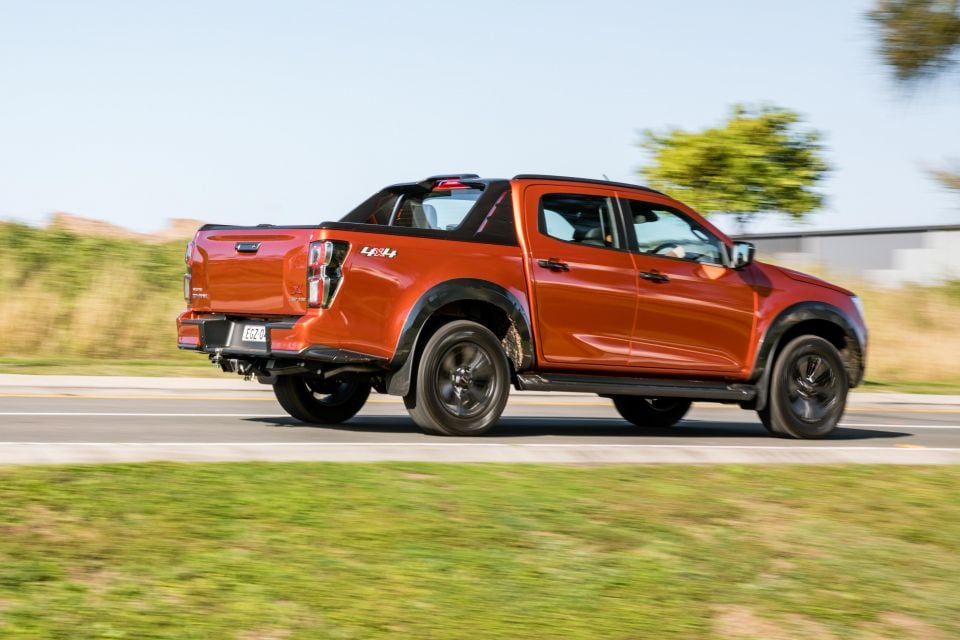

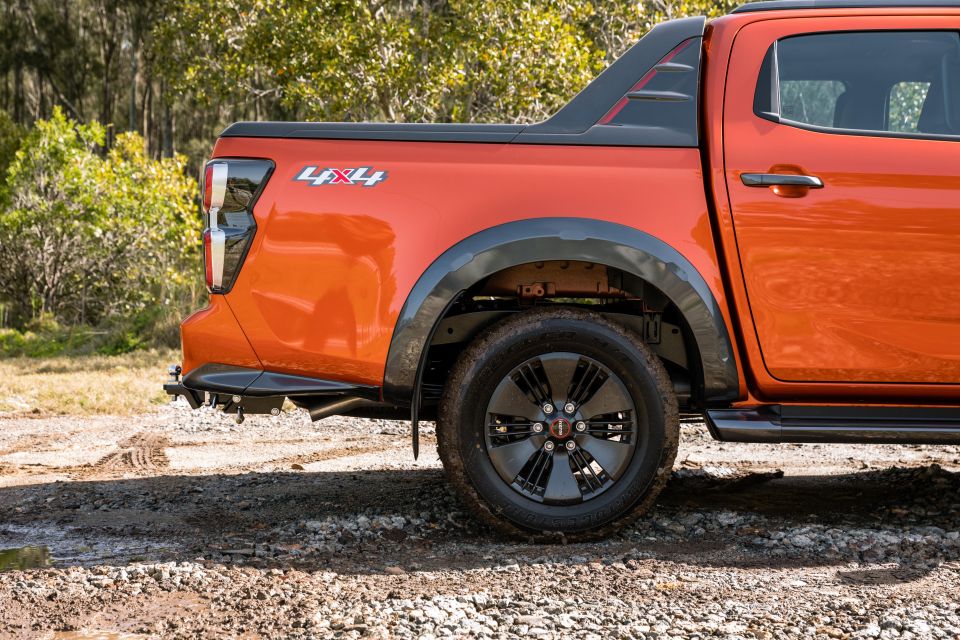
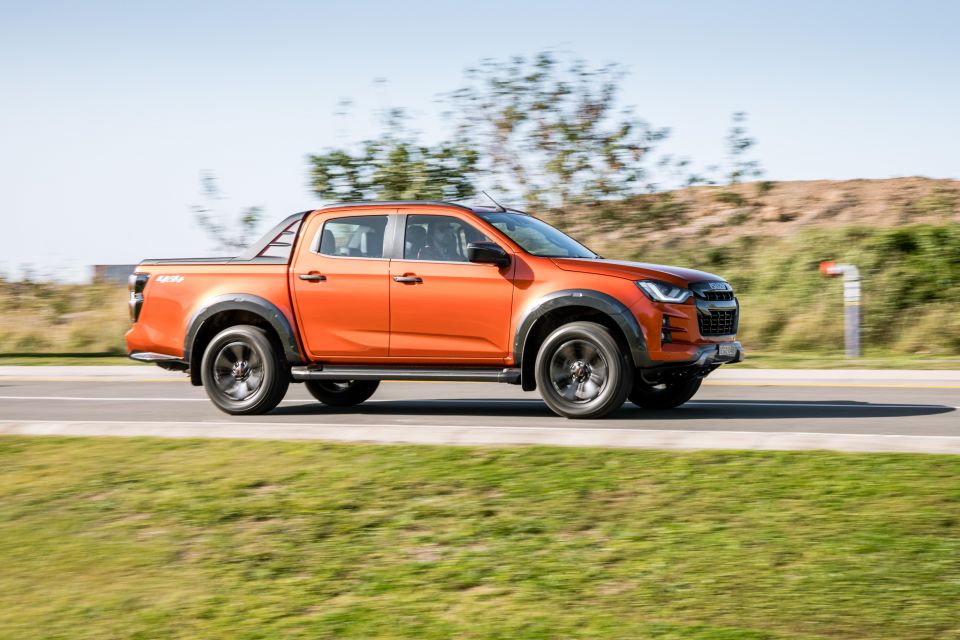
Isuzu
The revised 3.0-litre is quieter than before, both at idle and under load, and the throttle take-up point is well sorted, meaning you get a really rapid hit of power and torque pushing you back into your seat.
It’s not the dynamo that the Amarok’s V6 is (at 10 seconds to 100km/h, the Isuzu is more than two seconds slower), but it’s smoother and punchier than before.
The gearbox is clever enough to stay in the same gear and lean on the torque band instead of hunting, and it remains smooth when moving up and down gears. Unlike some diesel engines, which almost immediately drop off, there’s still at least 300Nm of torque available at 4000rpm.
The hydraulic power steering of the outgoing D-Max has been replaced with an electrically-assisted setup that’s far easier to use around town. It’s light and easy to manoeuvre, and such a system also allows the fitment of lane-keeping aids. It also means it’s devoid of the rack rattle and kickback you could experience at times in the outgoing D-Max.
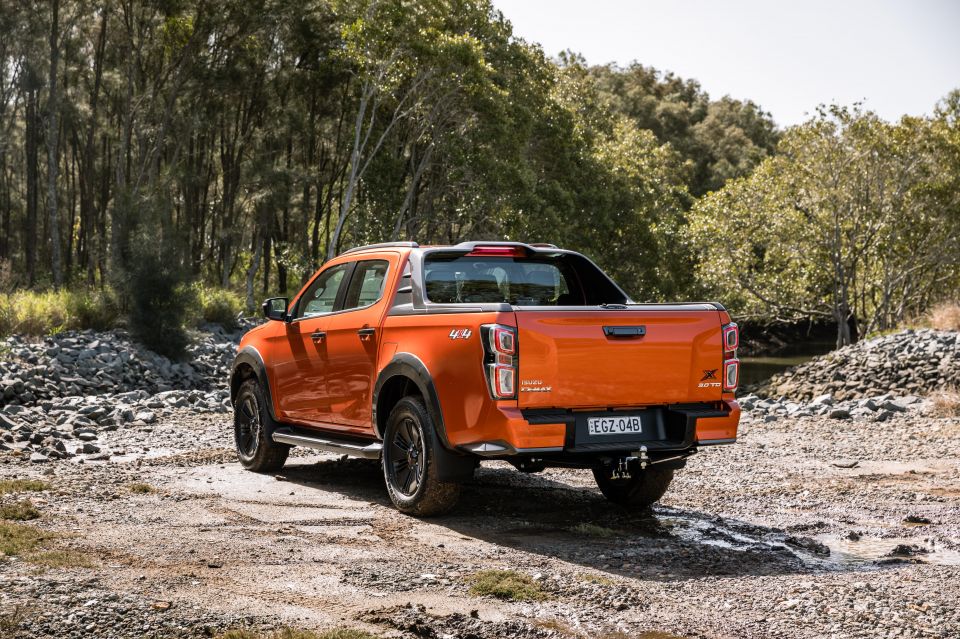

The ride quality at low speeds in particular is exceptional, up there with the Aussie-tuned Ranger. It isolates you from cobblestones and speed humps with aplomb, and removes the hard edge to brittle surfaces that would typically unsettle a dual cab ute. It makes for a very pleasant drive, and puts the D-Max in a good place for lifestyle-oriented families.
Out on the highway and on coarse chip country roads, cabin noise isolation is excellent. It seems like Isuzu put a lot of effort into cabin noise deadening, and preventing intrusion from wing mirrors and external parts exposed to the wind.
In terms of off-road equipment, the D-Max finally comes with a locking rear differential. It drives as a full-time two-wheel drive (sending torque to the rear wheels) with the ability to switch to four-wheel drive high range on unsealed surfaces on the move and into a four-wheel drive low range when stopped.
Ground clearance comes in at 240mm, while wading depth has increased to an impressive 800mm. There’s an approach angle of 30.5 degrees, a departure angle of 24.2 degrees, and turning circle of 12.5 metres kerb-to-kerb.
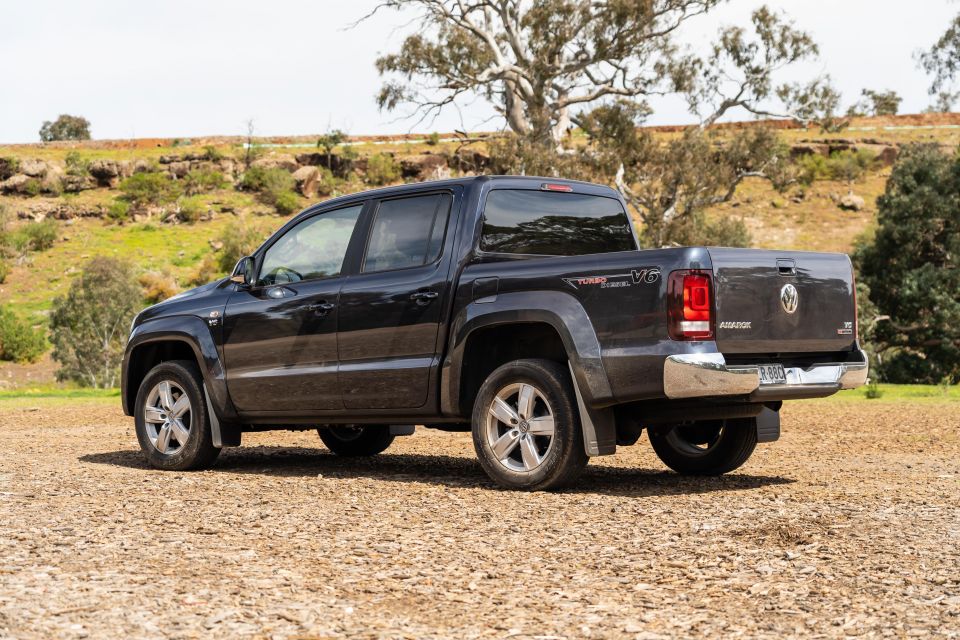
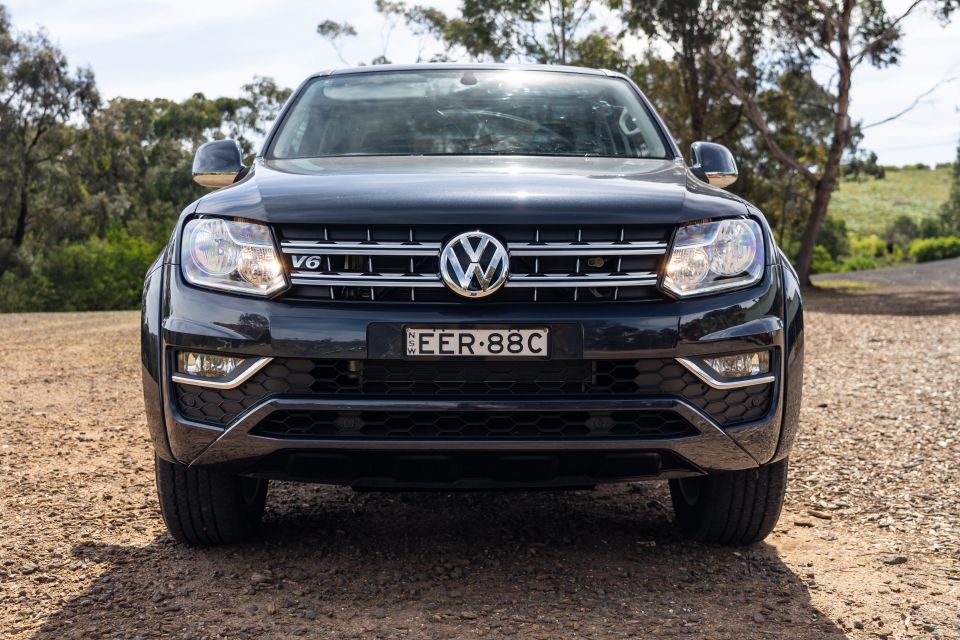
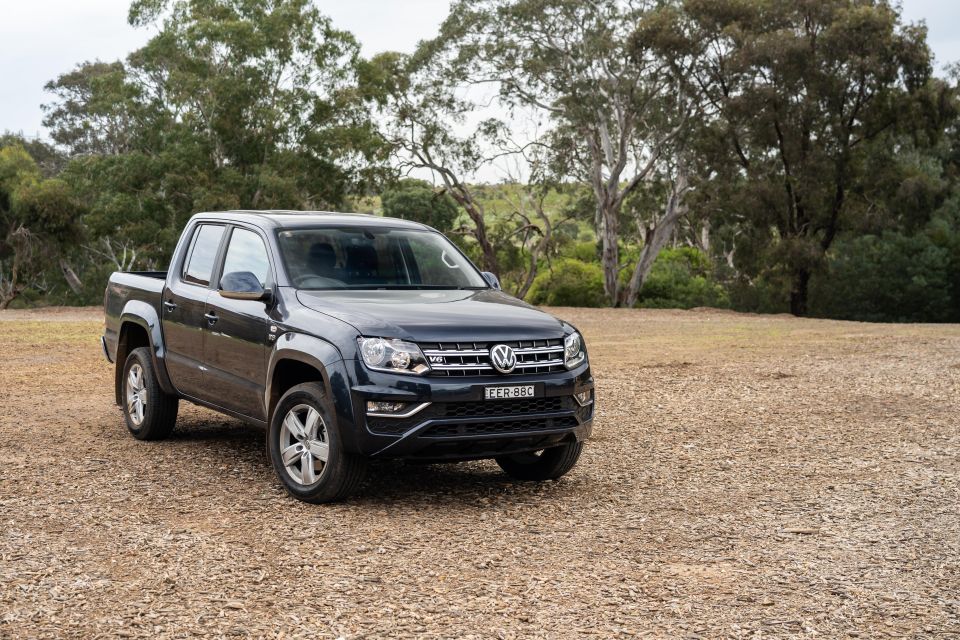
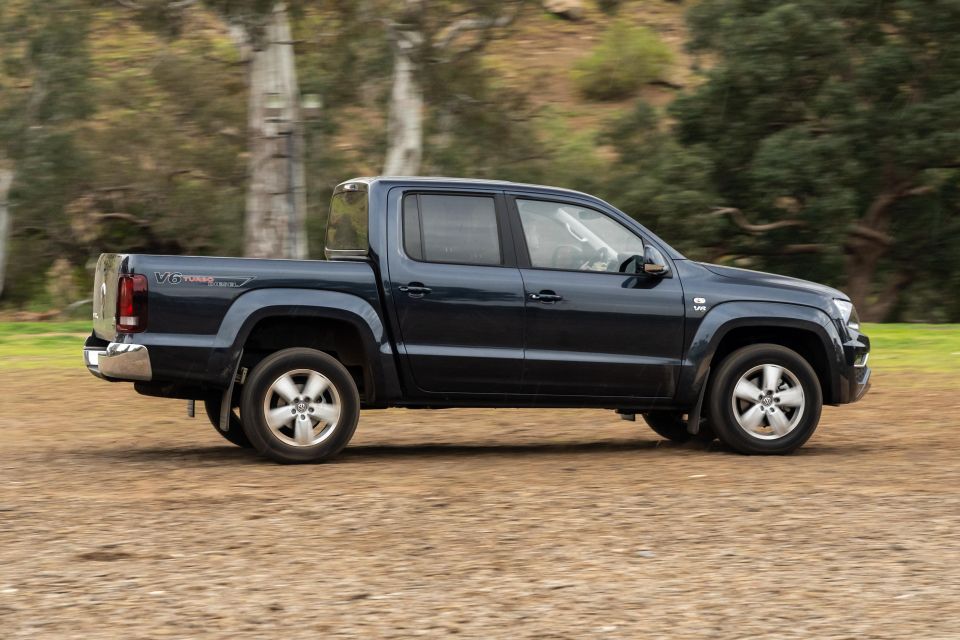
Where expert car reviews meet expert car buying – CarExpert gives you trusted advice, personalised service and real savings on your next new car.
Volkswagen
The V6 diesel engine has been used across numerous VW Group SUVs, so its refinement levels are good – though there are some vibration through the pedals at idle.
VW claims a 0-100km/h sprint time of 7.9 seconds, and I achieved precisely that on the first try. That’s quick for a diesel ute, and matches the performance we’d have probably demanded of a hot hatch only 10 years or so ago. It’s also a full two seconds faster than the D-Max.
The best thing about having a torque-rich engine is the confidence it inspires. You always have reserves left over for brisk overtaking manoeuvres. I’ve also towed extensively with the V6 Amarok before, and found it the most relaxed and responsive with such a load. If I had a big boat or float that I needed to lug regularly, I’d look no further.
The permanent 4WD means the Amarok has a level of sure-footedness and plenty of grip on gravel and wet bitumen, unlike some utes that tend to skip about and lean on the stability control to cut in.
The fitment of 300mm diameter rear ventilated disc brakes also means you pull in rapidly, and an off-road braking mode changes the ABS characteristics to halt you quicker on gravel. Check out the video below to see it in action.
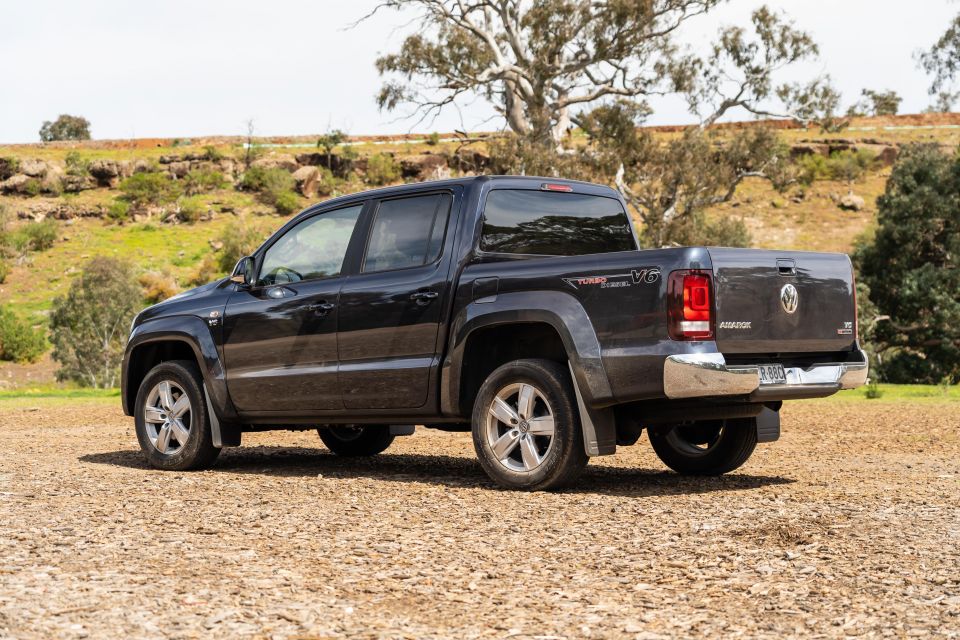

You sit quite low in the Amarok, and the pseudo-sporty feeling is enhanced by the cabin’s sense of width, The hydraulically assisted steering offers more resistance and road feel than the D-Max’s EPAS but is never overly heavy, and it’s fairly responsive from centre allowing quick directional changes. This is a very agile pickup.
The ride quality over crappy roads is pretty good, on account of plentiful tyre sidewall. The leaf-sprung tub-end does skip around a little when sans load, and the body never feels totally settled, but that only enhances the sensation of agility the Amarok offers. If there’s such a thing as a taut sports ute any more, it’s this.
Off-roading is simple. In lieu of traditional low-range, you shift the gear stick into its manual mode and put it into the uber-short first or, for downhill runs above 10 degrees, hit the active-braking hill-descent control button on the transmission tunnel (marked Off Road). This off-road setup also controls individual wheel-braking. If a back tyre is free-wheeling madly in the air without surface contact, you can engage a rear diff lock to help.
If you prefer a conventional 4×4 system that reverts to rear-drive and has low-range reduction gearing, then the V6 Amarok with manual gearbox (and a subsequent 50Nm torque reduction) is the one for you.
But for most lighter-duty 4×4-ing, the Amarok V6 auto’s point-and-shoot nature and ability to just walk all over obstacles are surprisingly good.
| Isuzu D-Max | Volkswagen Amarok | |
|---|---|---|
| Length | 5280mm | 5254mm |
| Body width | 1880mm | 1954mm |
| Height | 1810mm | 1878mm |
| Clearance | 240mm | 192mm |
| Payload | 970kg | 976kg |
| Unladen weight | 2130kg | 2104kg |
| GVM | 3100kg | 3080kg |
| GCM | 5950kg | 6000kg |
| Brakes | Disc/drum | Disc/disc |
| Steering | EPAS | Hydraulic |
| Approach angle | 30.5 | 28 |
| Departure angle | 24.2 | 23.6 |
| Breakover angle | 23.8 | 23 |
Isuzu offers a six-year or 150,000km warranty, and seven years of capped-price/advertised servicing prices. The intervals are annual or 15,000km, and the first five visits are respectively advertised at: $389, $409, $609, $509, and $299. All up that’s $2215.
The Volkswagen comes with a five-year/unlimited-kilometre warranty, and advertised servicing prices at intervals of 12 months or 15,000km.
The costs of the first five visits at the time of writing were: $478, $677, $571, $841, and $478. However, you should purchase a ‘5-Year Care Plan’ at purchase time for $2300, which will save you $745. No brainer…
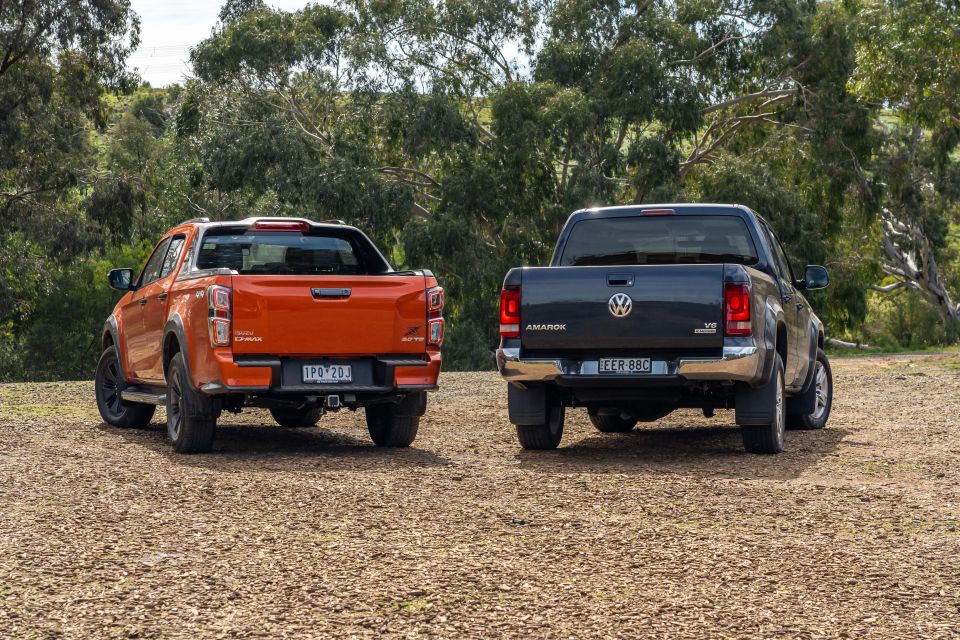
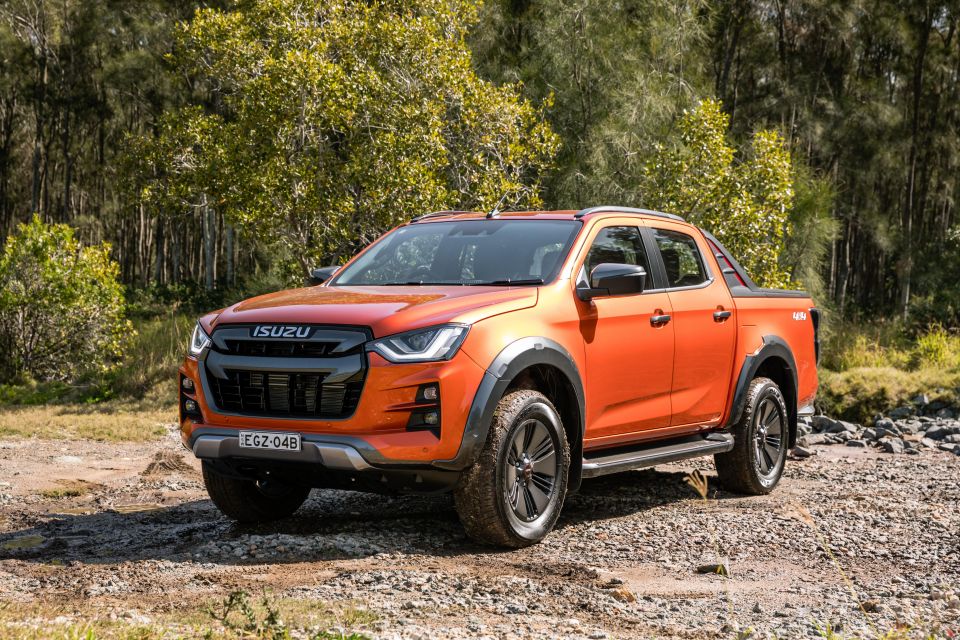
The evergreen Amarok still has a real ace up its sleeve: that potent diesel V6 that simply leaves its immediate competitors in the dust. For those users not regularly doing off-roading, the permanent 4WD system is also better.
Moreover, it’s still offers impressively car-like handling. It’s a ute that’s quite fun to drive hard. The fact that the elderly statesman of the ute market still has the best drivetrain is an indictment on the others.
But in every other area the D-Max outclasses the Amarok. Its ride quality is cushier and less fidgety, particularly when unladen. Its diesel engine lacks the Amarok’s poke but still delivers a decent shove off the mark and retains the signature relaxed demeanour at a cruise without the old model’s harshness.
It’s also a generation ahead in terms of interior design, material tactility, infotainment, and active safety. For the majority of users it delivers a better package. Particularly those using it as a family car.
Share your thoughts with us in the comments below!
Share your thoughts and write a review of a car you own and get featured on CarExpert.


Matt Campbell
4 Hours Ago


William Stopford
20 Hours Ago


Josh Nevett
21 Hours Ago


Ben Zachariah
2 Days Ago


CarExpert.com.au
2 Days Ago


Damion Smy
2 Days Ago